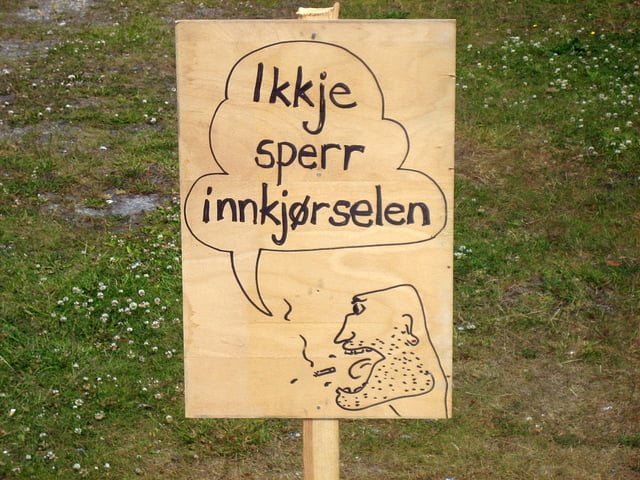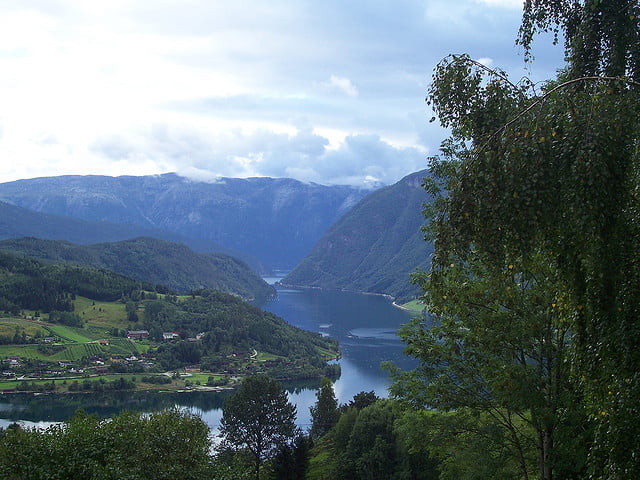
This is the second post in a series on the great Norwegian language struggle between Bokmål and Nynorsk. Click here to read the background post! This post is written by Bryce, a student of Nynorsk…
Having read my last two articles on how to say please in Norwegian, and how to say thank you in Norwegian too, you may be wondering how someone who can only spell venlegst [vennligst] correctly in square brackets after having spelt the same word incorrectly could possibly have the CAJONES to lecture to YOU about how YOU should use Norwegian. How dare you talk about my cajones like that! It's not spelt wrong; it's Modern Norwegian, also known as Nynorsk.

I know what you're thinking: hang on, how does he know what I'm thinking? Was I right? No? Okay, how about: what is this Modern Norwegian? How is it different from Bokmål, G-d's own language? Why does it even exist? Is this part of some conspiracy to make Norwegian even more difficult to learn?
To answer all these question thoroughly, I need to write several leather-bound volumes conveying detailed knowledge in the fields of language history, sociolinguistics, and comparative grammatics. But since I don't have the patience to do that right now, I'm going to just split this infinitive and give you a quick run-down on how to cheat at reading Modern Norwegian by turning it into Bokmål.
I must warn you that this is probably going to be an extremely dry list of one-way correspondences, so in order to mitigate boredom, I've hidden six clues in the text which explain the location of a treasure (actually, I haven't, but that would be fun, wouldn't it?). The aim here is to have a post which I can point to explaining a bit about Modern Norwegian to help those readers who can't read Modern Norwegian yet (that way, I don't have to keep on writing stoopid Bokmål in stoopid brackets stoopid).
I'm going to divide up the differences between Modern Norwegian and Bokmål into the following categories: geminates, palatals and breaking, consonant alterations, diphthongs and common vowel alterations, inflections, and finally miscellaneous. Confused? Yeah, well, linguistics is hard bro/sis. I'll try to explain the terms as we go along, and there will be lots of examples, and so many tables your eyes will pop out of your head and onto your keyboard in sheer delight.
Geminates
This is where two consonants of the same kind come together (like the star sign gemini is two twins). Bokmål uses geminates a lot more than Modern Norwegian (the reasons for this are boring and historical), so if you come across a word you're not sure of, try doubling the middle or final consonants, and you might get something more recognisable.
| Nynorsk | Bokmål | English |
| Gut | Gutt | Boy |
| Gamal | Gammel | Old |
| Ven | Venn | Friend |
| Glas | Glass | Glass |
Palatals and Breaking
Two exciting terms here (I'm sure you can handle it); palatal basically means “j”s all over the place, and breaking means pretty much the same thing. The reason I've given them two different names here is very linguistically involved, and I wanted to show off my skills. Impressed? No? Then we'll move on.
Modern Norwegian loves the j-sound loads more than Bokmål. A lot of Modern Norwegian verbs have a “j” on the stem, and even some nouns, too. The trick here then, is to remove the “j” and see if it's any closer to something in Bokmål.
| Nynorsk | Bokmål | English |
| Å røykje | Å røyke | To smoke |
| Å sitje | Å sitte | To sit |
| Å spørje | Å spørre | To ask |
| Kyrkje | Kirke | Church |
| Rekkje | Rekke | Row |
| Ikkje | Ikke | Not |
Both Modern Norwegian and Bokmål are guilty of breaking (technically, it's only Bokmål, but then we'd need to introduce another term, and it's enough already), and to make things more complicated, they both do two different kinds. I'm going to show you the table first, and then once you've gathered all the pieces of your brain together again, I'll talk you through it.
| Nynorsk | Bokmål | English |
| Sjuk | Syk | Ill |
| Ljos | Lys | A light, candle |
| Å stele | Å stjele | To steal |
| Eg | Jeg | I |
The first two rows show that Modern Norwegian “ju” and “jo” sometimes correspond to Bokmål “y”. What's happened here is that the “broken” sounds “j-u” and “j-o” correspond to the unbroken “y” (think of broken and unbroken here as interrupted and uninterrupted, like the j-sound is interrupted by a u-sound, and the y-sound is an uninterrupted y-sound). In the next two rows, the Modern Norwegian “e” has been broken into “je”. So the tips for this chart is to turn ju,jo → y and try adding a “j” before the “e” to see if you can get a more Bokmål-ish word.
Phew! Okay, take a break, go get yourself a cup of tea and relax for a bit (it's what I'm doing). Now, onward, to part two!

